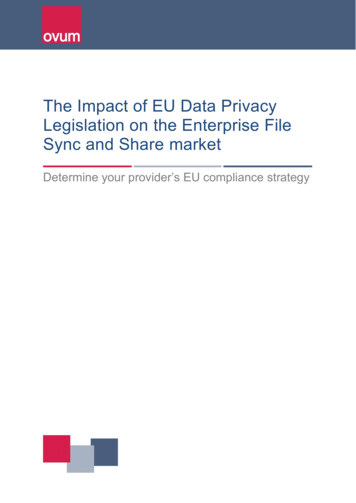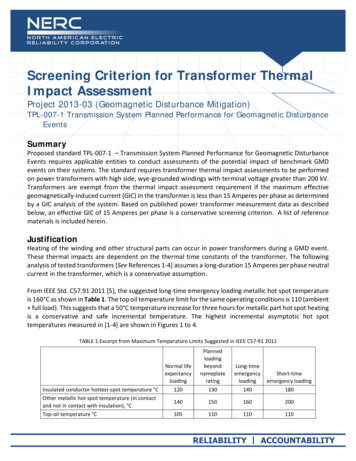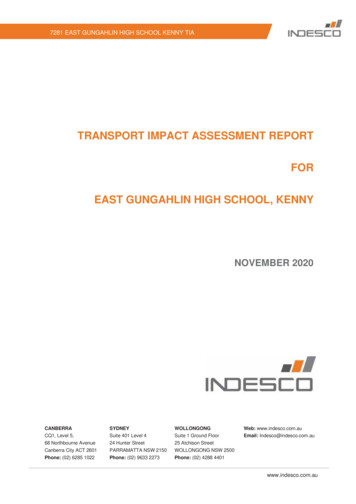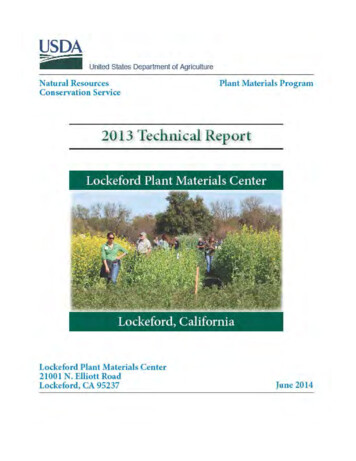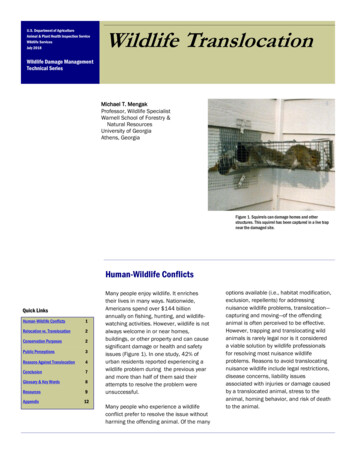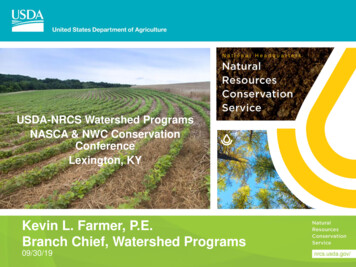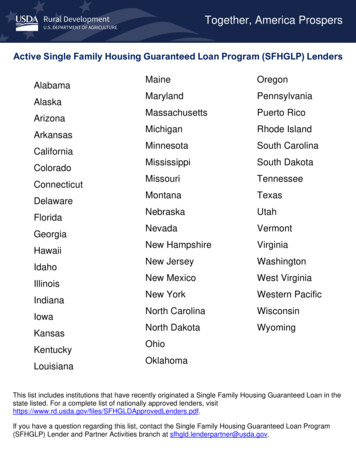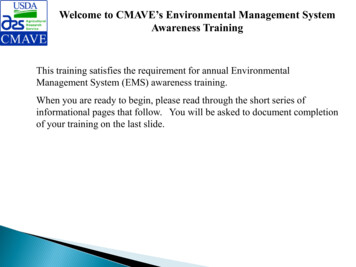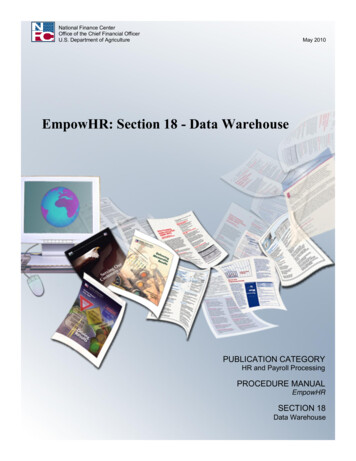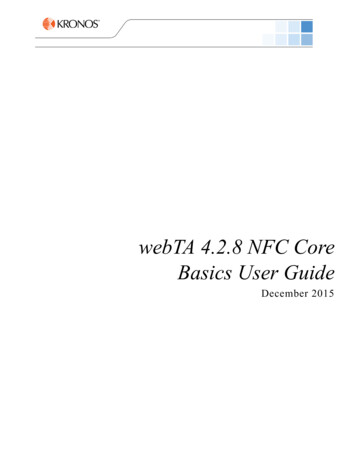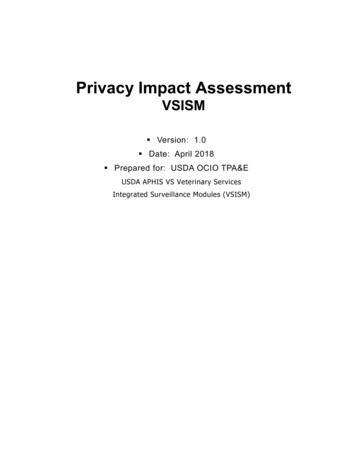
Transcription
Privacy Impact AssessmentVSISM Version: 1.0 Date: April 2018 Prepared for: USDA OCIO TPA&EUSDA APHIS VS Veterinary ServicesIntegrated Surveillance Modules (VSISM)
Privacy Impact AssessmentUSDA-APHIS-VSISMPrivacy Impact Assessment for theVeterinary Service Integrated SurveillanceModules (VSISM)April 2018Contact PointElinor GallelliUSDA APHIS Veterinary ServicesReviewing OfficialTonya G. WoodsAPHIS Privacy Act OfficerUnited States Department of Agriculture(301) 851-4076Danna L. MingoPrivacy Compliance OfficerInformation Security BranchUnited States Department of Agriculture(301) 851-24873
Privacy Impact AssessmentUSDA-APHIS-VSISMAbstract This Privacy Impact Assessment (PIA) is for the USDA, Animal and Plant HealthInspection Service (APHIS), Veterinary Services (VS), Veterinary ServicesIntegrated Surveillance Modules (VSISM).USDA APHIS VSISM is an enterprise-level (business-wide) animal health andsurveillance electronic information management system. It provides an electronicmeans of data input, data transmission, data storage, and data reporting. Thissystem enables USDA APHIS to take a comprehensive and integrated approach tocollecting and managing animal health data for disease management andsurveillance programs.This PIA was conducted as part of the initial Assessment and Authorization (A &A).OverviewThe USDA APHIS VSISM is an animal health and surveillance system which providesenterprise-level surveillance and animal health program data for numerous species anddiseases to facilitate the detection, management, prevention, investigation, control anderadication of animal diseases.The USDA APHIS VSISM maintains three types of data depending on the stream andcondition of interest: Syndromic ObservationsLab Submission Test Orders and ResultsCompliance Observations Syndromic ObservationsThese are qualitative observations about a given animal grouped by important clinicalsubdivisions of the animal such as the nervous system, cardiovascular or musculoskeletal.This data is not characteristic of a disease, but of an animal. It can be used to assess theprobability of a given disease and thus inform testing requests and epidemiological surveys.Currently some submissions capture clinical signs, but it is in reference to a specific disease,and there is no cross program standard. Lab Submission Test Orders and Results4
Privacy Impact AssessmentUSDA-APHIS-VSISMThese include the recording of laboratory test results and interpretations for specimenssubmitted to a diagnostic lab. These results and interpretations are specific to a condition,unlike the recording of syndromic observations which may be related to more than onecondition. Test results represent a quantitative determination of a given disease incidence inan animal determined through testing of specimens taken from the animal. The results areused to support specimen or animal level interpretations which have direct surveillanceconsequences. Compliance ObservationsThis third category is comprised of observations of the operating parameters of a facilityengaged in specific production practices characterized by discrete quantitative or semiquantitative parameters. For example, a waste feeder facility may require the temperature ofthe cooker to be within a certain range, or a herd or flock certification program may haverequirements in place regarding fencing, allowed feed, etc. In general this data will becharacteristic of either the premises or the animal group as a whole, not of individual animals.The USDA APHIS VSISM supports the Veterinary Services mission to protect and improvethe health, quality, and marketability of our nation's animals by providing a nationwiderepository of animal health and productivity information.USDA APHIS VSISM also maintains name, address, and phone information for individualsidentified as contacts for premises (locations) and owners of animals or animal relatedoperations involved with the various programs. Because of the variable nature of thepremises, including sole proprietorships, and the undocumented relationship of the contact tothe premises, many of the contacts are private citizens.The USDA APHIS VSISM is funded by Congress through appropriated funds fromVeterinary Services. This is a new system that is following the Authorization andAccreditation process to receive an Authority to Operate (ATO) in 2018. VSISM has asecurity categorization of “Moderate”1 Section 1.0 Characterization of the InformationThe following questions are intended to define the scope of the information requested and/orcollected as well as reasons for its collection as part of the program, system, rule, ortechnology being developed.1.1 What information is collected, used, disseminated, ormaintained in the system?5
Privacy Impact AssessmentUSDA-APHIS-VSISMInformation/Record TypeComponent Data (Examples)PremisesPhysical location of business or animal herd/flockObservationsIncludes observations about the location, subjects, and samplecollectedSurveillanceTest submission information and test results for diseases suchas Classical Swine Fever, Swine Brucellios, Pseudorabies, orFoot and Mouth DiseaseSubjectSubject species, breed, sex, age, classification, and anyassociated individual or group identifiersOtherSpecific ad-hoc data, miscellaneous identification numberssuch as the regulatory official ID, animal observations at thecollection site, compliance observations, and licensinginformation for persons and locationsLabTesting LaboratoryData Collection StreamMethod or means by which the data is being collected, suchas On-Farm Slaughter, Slaughter Marker, or Diagnostic LabCommodity GroupOverall surveillance program such as Swine HealthPerson InformationName, contact information for collector, submitter, owner,designated epidemiologistTest ResultsLaboratory and field testing results and interpretation1.2 What are the sources of the information in the system?There are two sources of information for the USDA APHIS VSISM: Collection information from visits to production facilities, slaughter plants, orother locations6
Privacy Impact AssessmentUSDA-APHIS-VSISM Laboratory results from diagnostic laboratories both in NAHLN and privatelaboratories1.3 Why is the information being collected, used,disseminated, or maintained?The purpose of the USDA APHIS VSISM system is to allow animal health officials toeffectively manage animal disease, pest and surveillance programs including providing:a. rapid detection and effective response to animal disease and animal pest events in theUnited States thereby reducing the spread of infections to new flocks/herds;b. epidemiological analysis, including animal tracing, diagnostic testing, surveillanceactivities, and other factors of epidemiologic importance for evaluating disease risk;Summarized animal disease information is reported to the (OIE) Office International desEpizooties (World Organization for Animal Health). Some animal disease information isshared with world trading partners provided for risk analysis to demonstrate that USagricultural animal products are safe for export to other countries. Most risk analysisinformation is aggregated information and does not describe detailed record information.Some animal disease information is shared with state and federal wildlife agencies, as animaldisease frequently crossover between domesticated animals and wildlife.Some animal disease information is shared with state and federal public health agencies, asanimal disease can crossover between domesticated animals and humans.All information for a State, by definition, is shared with state animal health officials and stateanimal health databases for that State. State employees who are authenticated users haveaccess to all the data collected about animals in their state. Federal users have access to data tomeet the mission of Veterinary Services. State partners use the information to manage animaldiseases in their state.1.4 How is the information collected?The information collected from states, users, individuals and/or businesses in the generalpublic is collected on OMB approved form VS 10-4. In some cases, the information is entereddirectly into the USDA APHIS VSISM application by animal lab employees who are enteringresults from their internal lab documents or a state or federal employee entering informationprovided in person, over the phone, in an email, or letter by a producer. Members of thepublic do not access system to enter data themselves. Data is input by authenticated state andfederal employees.7
Privacy Impact AssessmentUSDA-APHIS-VSISM1.5 How will the information be checked for accuracy?Data collected from customers, USDA sources and non-USDA sources are verified foraccuracy, relevance, timeliness and completeness by USDA and state employees at the timethe data is collected. These employees are responsible for the review and accuracy of the data.Verification of data records occurs on an as-needed basis. Person address information onlyprovides value during the lifecycle of the laboratory testing process and is not validatedbeyond the time of collection. Also, there are limited systematic data entry constraints toensure entry completeness.1.6 What specific legal authorities, arrangements, and/oragreements defined the collection of information? The Animal Damage Control Act of 1931, 7 U.S.C. 8301 et seq. of the AnimalHealth Protection ActThe Animal Health Protection Act, 7 U. S. C. 8301-83177 USC Sec. 7629The Farm Security and Rural Investment Act of 2002Public Health Security and Bioterrorism Preparedness and Response Act of 2002116 Stat 674-678The Homeland Security Presidential Directive 9.Farm Bill as approved by Congress1.7 Privacy Impact Analysis: Given the amount and type ofdata collected, discuss the privacy risks identified andhow they were mitigated.Unauthorized disclosure of employee and other personal data, as identified in Section 1.1above, was the primary privacy risk identified in the PTA. USDA APHIS, including the VSExecutive Team, District and Commodity Directors, Assistant District Directors, Centers forEpidemiology and Animal Health (CEAH), Surveillance Design and Analysis (SDA) andState Veterinarians are all responsible for protecting the privacy rights of the employees andother persons identified in the VSISM as required by applicable State and Federal laws.Specific mitigation activities are: All access to the data in the system is controlled by formal authorization. Eachindividual’s supervisor must identify (authorize) what functional roles thatindividual needs in the USDA APHIS VSISM system.Access to USDA APHIS VSISM is controlled by the USDA eAuthenticationsystem and/or APHIS VPN.8
Privacy Impact AssessmentUSDA-APHIS-VSISM The application limits access to relevant information and prevents access tounauthorized information.All users receive formal system training and are required to sign Rules of Behavioron an annual basis as part of the USDA mandatory information system securityawareness training.At the login screen of the application the warning banner must be acknowledgedbefore users are allowed access.2 Section 2.0 Uses of the InformationThe following questions are intended to delineate clearly the use of information and theaccuracy of the data being used.2.1 Describe all the uses of information.The data is used for routine animal health surveillance, management of domestic animaldisease and pest control programs, and to monitor for and respond to the introduction offoreign animal diseases.State Veterinarians and State Animal Health officials, as co-owners of the data, have thediscretion to share information stored in the USDA APHIS VSISM relevant to premises orpersons within their state in accordance with state laws and regulations via public web sitesand/or may store such information in animal health and surveillance management databasesdeveloped by State IT developers, contractors or other third party software vendors in amanner that provides secure data access.Certain disease information reported by State and/or Federal employees is recorded in USDAAPHIS VSISM. These reports are then summarized by APHIS in reports to the (OIE) OfficeInternational des Epizooties (World Organization for Animal Health). No ‘customer’,‘employee’ or ‘other’ private information is published or distributed to OIE.The Center for Epidemiology for Animal Health (CEAH) and the Commodity Health Centershave agency responsibility for reporting surveillance and program management activities on anationwide basis. The CEAH and the Commodity Health Centers will have direct access tothe USDA APHIS VSISM and provide and publish summarized data to the public and ourtrading partners.2.2 What types of tools are used to analyze data and whattype of data may be produced?9
Privacy Impact AssessmentUSDA-APHIS-VSISMUSDA APHIS VSISM uses business analysis tools such as Alteryx and Tableau. Data is alsoanalyzed in Excel spreadsheets and by using SAS (a statistical application). Aggregated datais used to produce summary reports for stakeholders.2.3 If the system uses commercial or publicly available dataplease explain why and how it is used.USDA APHIS VSISM does not use commercial or publicly available data.2.4 Privacy Impact Analysis: Describe any types of controlsthat may be in place to ensure that information ishandled in accordance with the above described uses. Privacy rights of the employees and other persons will be protected by USDAAPHIS VS management within the limits of the Privacy Act of 1974. USDAAPHIS VSISM has security controls to address access/security of information.All access to the data in the system is controlled by formal authorization. Eachindividual’s supervisor must identify (authorize) what functional roles thatindividual needs in the USDA APHIS VSISM application.All requests for access to the system are verified by user identification andauthentication. Users must have a government issued login and password that iscontrolled and managed either at the Veterinary Services, National, District orlocal offices or in the case of local State databases the State Veterinarian’s office.The USDA APHIS VSISM application limits access to relevant information andprevents access to unauthorized information through role-based access.All users receive security basics training and are required to sign rules of behaviorbefore being given access to the system. Additionally, all users receive securitybasics refresher training and sign rules of behavior on an annual basis.At the application login screen the warning banner must be acknowledged beforeusers are allowed to log into the application.3 Section 3.0 RetentionThe following questions are intended to outline how long information will be retained afterthe initial collection.3.1 How long is information retained?10
Privacy Impact AssessmentUSDA-APHIS-VSISMThe records within the USDA APHIS VSISM application are considered permanent until theactual records retention scheduled is approved by NARA.The proposed schedule will be as follows: Individual electronic records will be retainedwithin the system for 150 years from the last date of creation, edit, or access of thoseindividual records or their child records. The location of an animal disease infection is ofimportance to APHIS for epidemiological analysis such as determining the effect of climateor other changes on disease patterns. Further, studies have shown that disease agents mayremain in the environment for years after initial occurrence.3.2 Has the retention period been approved by thecomponent records officer and the National Archives andRecords Administration (NARA)?This is in progress. USDA APHIS VSISM is taking necessary action to ensure that the MRP400 is completed and submitted to NARA.3.3 Privacy Impact Analysis: Please discuss the risksassociated with the length of time data is retained and howthose risks are mitigated.Unauthorized disclosure of contact information, as identified in Section 1.1 above, is theprimary privacy risk, as identified by the PTA. Personally Identifiable Information (PII) islimited to names, addresses, email and phone numbers of submitters/collectors andpremises/animal owners.The benefit of having that data available for premises backtracking and other trendinginformation during an emergency overrides any risk due to data retention timescale. Allrecords will be retained as VS awaits NARA disposition and retention scheduling. USDAAPHIS VSISM maintains information in a secure manner and will disposes of information perAPHIS Directive 3440.2 and approval NARA disposition authority.4 Section 4.0 Internal Sharing and DisclosureThe following questions are intended to define the scope of sharing within the United StatesDepartment of Agriculture.11
Privacy Impact AssessmentUSDA-APHIS-VSISM4.1 With which internal organization(s) is the informationshared, what information is shared and for whatpurpose?All data is available (for the areas/states for which they have responsibility) to USDA APHIS,including District and Commodity Directors, Assistant District Directors, district and nationalstaff, Centers for Epidemiology and Animal Health (CEAH), Surveillance Design andAnalysis (SDA), for program implementation, oversight, and reporting.4.2 How is the information transmitted or disclosed?The APHIS and state users have access to the USDA APHIS VSISM through the APHISEnterprise Infrastructure (AEI) and National Information Technology Center (NITC) GeneralSupport System (GSS) via Tableau and Alteryx tools for reporting or direct database accesscontrolled through database roles.4.3 4.3 Privacy Impact Analysis: Considering the extent ofinternal information sharing, discuss the privacy risksassociated with the sharing and how they weremitigated.Unauthorized disclosure of contact information, as identified in Section 1.1 above, is theprimary privacy risk to information shared internally to APHIS. These risks are mitigatedthrough USDA APHIS VSISM and AEI & NITC GSS security controls as delineated in thecurrent USDA APHIS VSISM System Security Plan. Further, the animal health professionalswho have access to the data are trained in the proper use and dissemination of this data. Allaccess must be approved, before it is granted. VS, where feasible and within the technicallimitations, ensures activities within the VSISM are audited, PII is used only for authorizedpurposes and in a manner that is compatible with Privacy Act, and PII use is minimized to theextent necessary to meet the mission needs of the VS surveillance program.5 Section 5.0 External Sharing and DisclosureThe following questions are intended to define the content, scope, and authority forinformation sharing external to USDA which includes Federal, state and local government,and the private sector.12
Privacy Impact AssessmentUSDA-APHIS-VSISM5.1 With which external organization(s) is the informationshared, what information is shared, and for whatpurpose? USDA APHIS VSISM shares data with cooperating universities and researchers,other Federal agencies (Health and Human Services, Center for Disease Control,and Department of Homeland Security). However, no direct access to the data inUSDA APHIS VSISM is provided to these external organizations. USDA APHISVS staff pulls data as needed.Federal and State animal health officials use the information to monitor the statusof an animal disease investigation, document actions taken relating to an animaldisease investigation, track the status of animals susceptible to foreign animaldiseases, and assist with managing and analyzing animal disease and surveillanceprograms.Federal and State wildlife agencies use the information to assist in managing andanalyzing disease programs and monitoring diseases related to wildlife, feral oralternative livestock.Federal or State agencies involved with public health such as the Departments ofHomeland Security and Health and H
USDA APHIS VSISM uses business analysis tools such as Alteryx and Tableau. Data is also analyzed in Excel spreadsheets and by using SAS (a statistical application). Aggregated
